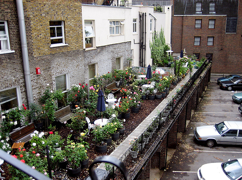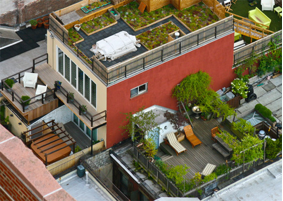I discovered a really great idea for gardening while at an independent film festival in Atlanta this weekend. The film featured environmentally friendly ideas from each of the 50 states. Chicago’s rooftop gardens instantly caught my eye.
The EPA started the Greenroofs project in April 2000, in an attempt to reduce the Heat Island Effect and improve air quality. In 2001, at a cost of $2.5 million, Chicago City Hall’s greenroof experiment was completed. The garden now encompasses 20,300 square feet of Chicago City Hall’s rooftop, with 20,000 herbaceous plants in 150 varieties.
It includes 100 woody shrubs, 40 vines and 2 trees—a Cockspur Hawthorn and Prairie Crabapple.

Although this was an expensive project, the city of Chicago felt some real benefits. Not only are they helping reduce the Heat Island Effect (the difference in temperature between a hot pavement area and a rural shaded area), they helped improve air quality. Just having the garden on their rooftop has lowered their utility bills by $5,000!
The Advantages of a Rooftop Garden
After doing some research, I learned you don’t have to have thousands of dollars to create your own rooftop garden. It’s actually quite simple. First let’s look at the advantages:
● Lower utility bills—saving money is always at the top of the list for me. Rooftop gardens can cool buildings down anywhere from 6 to 10 degrees. That means less money for you and a cooler environment for everyone.
● Gardening made possible without a yard—maybe you’re short on space or don’t have a full size yard to plant. A rooftop is the perfect space to grow your favorite flowers and plants. And who says gardening has to be just about shrubs and plants? You can even get crazy with it and plant tomatoes, barley, basil, or whatever strikes your fancy!
● More privacy—you don’t have to worry about the neighbor’s dog trampling your begonias or deer eating your veggies; on a rooftop you can create your own secret space and not worry about the safety of your masterpiece.
● Natural Habitat—a natural habitat can be a little piece of nature in the middle of a big city. There is nothing more satisfying than seeing flowers and plants growing amongst a city skyline. It can also be a nice romantic getaway!
Rooftop Gardens from Around the World
Chicago isn’t the only one who thought rooftop gardening was a great idea. Check out a few of the gardens I found to be extra awesome:

London residents show their gardening skills by taking a parking lot rooftop and turning it into a beautiful bustling garden.

This rooftop garden beautifully looks out upon the bay city of Seattle; a small diamond in the rough.

New York City residents make use of their small space with a cozy green space.
A Do It Yourself Garden
Even if you don’t have a green thumb, these gardens can be ideal for a new start to gardening. The best thing about a rooftop garden is that you can keep growing it. There’s no need to feel pressure earning a “Garden of the Year” award, because it can be as enchanting or as secret as you want. Here are some tips I put together to help you get started.
● Plant tough plants—make sure your plants can weather any weather. On a rooftop everything you plant comes into contact directly with the elements—rain, snow, sleet, strong winds, sunshine, etc. Some veggies that do well on rooftops include: carrots, radishes, potatoes, strawberries, onions, lettuce, red beets, cabbage, broccoli, cauliflower, and spinach.
● Check your Roof—one of the most important aspects of rooftop gardening is the structure itself. Consult a structural engineer or your landlord. A roof needs to be completely waterproof and be able to handle the extra weight of people and water. Remember: wet soil is heavier than dry soil. Also, an ideal rooftop is flat or slightly sloping.
● Choose the Right Pots—to avoid pushing your roof to its limit, try using plastic pots to plant your seedlings. This will alleviate stress to the roof and waterproofing concerns. If you live in an extremely dry, hot climate where plastic pots are easily damaged, you can get creative and use anything from old watering cans to wheelbarrows.
● Good tools and supplies—even though you are gardening on the roof, you still need a space for supplies like extra soil, gravel, gloves, and tools. Having easy access to these things will eliminate trips back and forth, and you can avoid extra clean up.
● Have Fun—above all, this is your space, so get creative. Don’t be afraid to think outside the box, or flowerbed. The sky’s the limit when it comes to rooftop gardens!
Images courtesy NREL; mollyeh11, nyc-travails-5118, Geek2Nurse on Flickr
Valerie Haggerty is an environmentally-savvy activist born and raised in Atlanta, GA. She enjoys writing about anything green and currently works for the tree lovers at the TreeLoversBlog.
Latest posts by Canadian Home Trends (see all)
- Creating the Perfect Outdoor Kitchen - April 17, 2024
- Classic Luxury Kitchen Design - April 17, 2024
- Color Journey: Spring 2024 - April 17, 2024








I am in the middle of building a new deck in a friends back yard. I have got great inspiration from this site on things I would love to learn how to do to offer in my business for peoples homes. Thank you for sharing all of your great ideas with us on here.